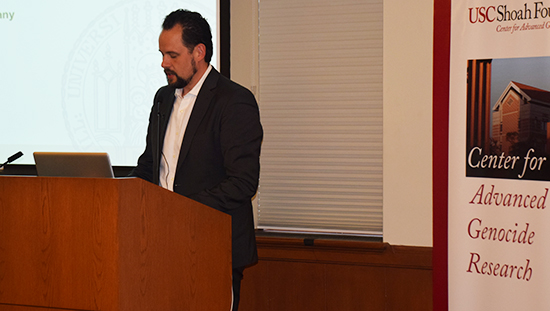Maximilian Strnad Lecture (Summary)
Maximilian Strnad, University of Munich
“The Fortune of Survival – Intermarried Jews in Nazi Germany”
November 19, 2015

Maximilian Strnad, a young German scholar who is currently a fellow at the US Holocaust Memorial Museum’s research center, gave a public lecture at the USC Shoah Foundation Center for Advanced Genocide Research focusing on the experiences of the last remaining Jews under the German Reich — intermarried Jews. Jews who were married to non-Jewish spouses were exempt from deportation until the final months of the war, but they and their spouses faced a range of persecutions that were at first designed to pressure the couples to divorce. As the war progressed, persecution of intermarried Jews intensified.
The statistics that Strnad presented offered powerful illustrations of both the consequences of the German Reich’s mass deportations of Jews and the changing fates of intermarried Jews as the war went on. In 1939, 330,000 Jews lived in Germany. Six percent of them were married to a non-Jewish spouse. In 1944, once the mass deportations had ended, only 14,288 Jews still remained in Germany proper. Of those, 85% were intermarried. Thus, the study of the remaining Jews in Germany is necessarily the study of intermarried Jews. Yet the experience of this group has not received deep scholarly attention up until now.
Focusing his lecture on the last years of the war, Strnad described the increasing pressure on mixed marriages from 1943 onwards. He illuminated significant regional variation in the patterns of persecution, offering powerful illustrations of differential targeting of intermarried Jews depending on the actions of local authorities. In some regions, even while the deportation of intermarried Jews was officially not allowed, local Gestapo rounded them up on the pretext of taking them into “protective custody.” This “protective custody” resulted in the deaths of hundreds of intermarried Jews since they had been transferred to the concentration camp in Auschwitz at a time when they were officially exempt from deportation.
Strnad also focused in detail on two key persecution measures -- intermarried Jews being used in labor battalions of the Todt Organization (OT) and the order for intermarried Jews to be deported to Terezin (Theresienstadt) in early 1945. In 1944, intermarried Jews, their Aryan spouses, and their children were deployed in large numbers to segregated labor battalions of the Todt Organization (OT). The numbers of those affected and the patterning of the targeting again varied by region. Strnad offered an in-depth analysis of what happened in a couple of regions (Military District VI and Breslau) to paint a powerful portrait of how OT labor deployment became a primary means of persecution beginning in 1944, enabling the expulsion of Jews from local regions at a time when deportation was not an option. When the first group of Jews from Military District VI arrived at their destination in Lower Saxony, they surprised the OT leadership there, who had not been notified of their arrival or involved in any plans. This highlights the local dimensions of such planning and decision-making. From the Breslau district, intermarried Jews were sent to OT camps too. When the Nazi authorities abolished or abandoned these camps in the final months of the war, the Jews there had to march on foot to concentration camps, many dying along the way.
In January 1945, the Reich Security Main Office lifted its previous exemption and ordered the deportation of all remaining Jews to Terezin (Theresienstadt). Strnad described how once again, the success of the deportations and the numbers of those deported varied dramatically by region. In some regions, deportations did not happen at all because of the ongoing assault by air raids. In others, people fled to avoid deportation. As they had so often in the years leading up to these last months of the war, regional particularities and differentiation decided the fate of intermarried Jews in Germany. Ultimately, 1,901 of the remaining 14,288 Jews in Germany (12,206 of them intermarried) were deported, most of them intermarried Jewish men.
One of the other highlights of Strnad’s lecture was his exploration of “privileged mixed marriage,” a category introduced by the Nazis in 1938 to describe those marriages in which the husbands were Aryan and the children were not being raised as Jews. This category created a hierarchy within intermarried Jews, as the couples in this “privileged” category experienced some concessions, such as not having to wear the yellow star of David, getting better food rations, and avoiding ghettoization. This status, which resulted in differential treatment earlier in the war, meant very little by the end. (For example, in their eviction of Military District VI, authorities did not differentiate between “privileged” and not). Partly because of this “privileged” label, after liberation these couples were perceived by some to not have suffered much as other Jews during the war and thus would not deserve the same support and food as other Jews. Unfortunately, this negatively affected their fate as they struggled to rebuild their lives.
Strnad’s lecture on the experiences of this understudied group provoked a lively and long-lasting Q&A.
To view his lecture, click here.
Summary by Martha Stroud
Like this article? Get our e-newsletter.
Be the first to learn about new articles and personal stories like the one you've just read.